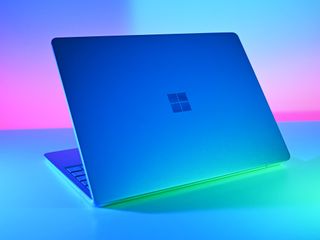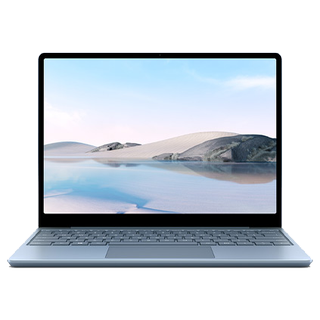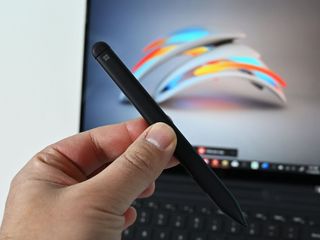

Portable, Affordable Notebook
The Surface Laptop Go is aimed at those who want a compact notebook built to premium Surface standards. Its display isn't as large or as high-res (with no inking capabilities) and there's no LTE connectivity, but it delivers 10th Gen Intel Core i5 performance and Wi-Fi 6. This is the right choice if you don't need the versatility of a 2-in-1 and don't want to deal with some of ARM's limitations.
For
- Starts at a more affordable price
- 10th Gen Intel Core i5 CPU
- Premium design and construction
- Easy to carry with you
- Available in three colors
Against
- No LTE connectivity
- Smaller, lower-res display
- No inking capabilities
- No keyboard backlight

ARM-Powered 2-in-1
The 2-in-1 Surface Pro X costs more than the Laptop Go, but it's packing more features. Higher-res touch display with inking, 4G LTE connectivity, superior cameras (including IR), replaceable storage, and two USB-C ports are included. As long as you don't mind running Windows on ARM and paying a bit more, the versatility here is unmatched.
For
- 4G LTE connectivity
- More versatile 2-in-1 build
- Slim, premium construction
- Larger, higher-res display
- Far better cameras
Against
- Starts at a higher price
- ARM has some limitations
- Type Cover and Slim Pen sold separately
- No 3.5mm audio jack
These two devices might come from the Microsoft Surface lineup, but they're actually quite different and will no doubt appeal to different types of users. Let's take a look at the raw specs before breaking down design, display, performance, and value.
Surface Laptop Go vs. Surface Pro X tech specs
| Header Cell - Column 0 | Surface Laptop Go | Surface Pro X |
|---|---|---|
| OS | Windows 10 Home in S mode | Windows 10 Home on ARM |
| Processor | 10th Gen Intel Core i5-1035G1 | Microsoft SQ1 Microsoft SQ2 |
| RAM | 4GB, 8GB LPDDR4x | 8GB, 16GB LPDDR4x |
| Graphics | Intel UHD Graphics Integrated | Adreno 685 Adreno 690 |
| Storage | 64GB eMMC 128GB, 256GB SSD | 128GB, 256GB, 512GB SSD |
| Display | 12.4 inches 1536x1024 (148 PPI) 3:2 aspect ratio Touch, no inking | 13 inches 2880x1920 (267 PPI) 3:2 aspect ratio Touch, inking |
| Ports | USB-C USB-A 3.5mm audio Surface Connect | Two USB-C Nano-SIM Surface Connect |
| Audio | Omnisonic speakers Dolby Audio | Dual 2W speakers Dolby Audio |
| Camera | Front-facing 720p | Front-facing 1080p Rear-facing 1080p and 4K |
| Connectivity | 802.11ax Wi-Fi 6 Bluetooth 5.0 | 802.11ac Wi-Fi 5 Bluetooth 5.0 Snapdragon X24 LTE |
| Keyboard | No backlight | Type Cover (optional) |
| Biometrics | Fingerprint reader | IR camera |
| Battery | Up to 13 hours* | Up to 15 hours* |
| Dimensions | 10.95 x 8.10 x 0.62 inches (278.18mm x 205.67mm x 15.69mm) | 11.3 x 8.2 x 0.28 inches (287mm x 208mm x 7.3mm) |
| Weight | 2.45 pounds (1.11kg) | 1.7 pounds (774g) |
| Material | Aluminum (top) Polycarbonate composite (bottom) | Anodized aluminum |
| Color | Ice Blue Sandstone Platinum | Matte Black Platinum |
*Real-world battery information below.
Surface Laptop Go vs. Surface Pro X design and features
The Surface Laptop Go is a rather petite notebook, and is the lightest of the Surface Laptop lineup (including the Surface Laptop, Laptop 2, and Laptop 3). Weighing in at 2.45 pounds (1.11kg) it's not as portable as the Pro X, but it's still not going to be much trouble for anyone constantly on the move. Wi-Fi 6 connectivity sets you up for a fast wireless future, but there's no LTE connectivity. For that you need to go with the Pro X and its Qualcomm Snapdragon X24 LTE modem, able to handle eSIM and Nano-SIM alike.
Because the Laptop Go is a notebook, you get everything you might need in one package. Conversely, the Pro X is a 2-in-1 device with its Type Cover keyboard and Surface Slim active pen generally sold separately (or bundled at a higher cost). A stand on the back of the Pro X props up the tablet portion for a notebook experience with Type Cover attached. At least you get a backlit keyboard with the Pro X, something the Laptop Go is missing. Typing is excellent on both devices, but if you're often working after hours, the lack of lighting could be an issue.

Ports are similar across devices, and in typical Surface fashion you won't be getting the most modern selection. The Laptop Go has a single USB-C, USB-A, 3.5mm audio, and Surface Connect. The Pro X has dual USB-C, Nano-SIM slot, and Surface Connect, ignoring those who still use wired headphones with a lack of 3.5mm jack. At least you can easily expand connectivity with something like a Surface Dock 2 that hooks up with the proprietary Surface Connect port.
If you're interested in photography or video work with your Surface device, the Pro X has the Laptop Go cornered. The Pro X has a front-facing 1080p camera ideal for video conferencing, plus an IR camera is included for facial recognition through Windows Hello. The back of the tablet has another camera that can handle 4K video. The Laptop Go has just one front-facing 720p camera. It does a good enough job, but the Pro X is what you want if you don't have a good backup camera on another device.
The Pro X was originally available only in a Matte Black color, but a mid-generation Pro X hardware refresh has also brought a Platinum chassis color and some new Type Cover finishes. The Laptop Go has from the start been available in Ice Blue, Sandstorm, and Platinum colors.
Get the Windows Central Newsletter
All the latest news, reviews, and guides for Windows and Xbox diehards.
Surface Laptop Go vs. Surface Pro X display and inking

Surface products always excel in the display department, but between these two devices the Pro X is the winner. It has a larger 13-inch screen with 2880x1920 resolution, resulting in 267 pixels per inch (PPI). The 3:2 aspect ratio is ideal, allowing you to fit more on your display. It's touch and it offers inking capabilities, further upping the versatility of the device.
The Laptop Go's display is a bit more basic, but still above what you'd usually expect from a device in the price range. It's sized at 12.4 inches with a resolution of 1536x1024, resulting in 148 PPI. That's about half as sharp as the Pro X, but at 12.4 inches it nevertheless looks great. Unfortunately, the Laptop Go's touch display doesn't have the option for inking. If you want to jot down notes, sketch drawings, and enjoy some of the best apps for the Surface Pen, it's the Pro X you want.
Surface Laptop Go vs. Surface Pro X performance and price
Windows Central Executive Editor Daniel Rubino has reviewed both the Surface Laptop Go and first-gen Surface Pro X, with the SQ2 version review coming in the near future. Focusing first on battery life, the Laptop Go managed between 7 and 8.5 hours according to a battery report generated by Windows, and about 8.75 hours in PCMark 10's battery rundown. That's with screen brightness at 150 nits.
Our testing of the Pro X revealed about 10 hours of battery life when sticking to ARM64 and UWP apps, dropping down to about 7 hours when using only emulated 32-bit x86 apps. On that note, keep in mind that Microsoft's SQ1 and SQ2 processors are tweaked versions of Snapdragon 8cx CPUs, meaning you will be emulating some apps. Performance isn't quite as good when not running natively, but the Pro X is still snappy for just about all productivity work. On a positive note, work is underway to make popular apps compatible with ARM, and x64 emulation for Windows on ARM is also on the way.

The Laptop Go is available with a 10th Gen Intel Core i5-1035G1 CPU, and in most cases it's going to overpower the SQ1 in terms of raw performance, both on the CPU and integrated GPU sides. However, it will be interesting to see how well the SQ2 version of the Pro X, with boosted CPU and GPU performance, will compare. Something the Pro X has going for it is the ability to upgrade the SSD, whereas the Laptop Go's storage is permanent.
As for pricing, the Laptop Go with Intel Core i5 CPU, 4GB of RAM, and 64GB eMMC storage starts at about $550. Moving up to something a bit more impressive (4GB of RAM and eMMC storage will seem slow), a model with Core i5 CPU, 8GB of RAM, and 256GB SSD costs about $900.
The Pro X begins at about $1,000 for a model with SQ1 CPU, 8GB of RAM, and a 128GB SSD. That's still more than the Laptop Go, plus you need to factor in the cost of a Type Cover and Surface Slim Pen if that's the way you're going. Expect to pay about $270 altogether for the accessories. Jumping up to the SQ2 model, 16GB of RAM and a 256GB SSD costs about $1,500. It's clear that while the Laptop Go doesn't come with as many premium features, its considerably lower price easily makes up the difference.
Surface Laptop Go is right for those who want an affordable premium notebook
If you don't want to deal with some of ARM's limitations and prefer to use a standard notebook, the Laptop Go should be more appealing. It doesn't have as nice of a display (and no inking), it's lacking LTE connectivity, and there's no keyboard backlight, but it's nevertheless a quality Surface device with excellent mid-range performance.

Looking for something with the same design as the Surface Laptop but easier on the wallet? Look no further with the Surface Laptop Go with its 12.4-inch display, Intel Core i5 processor, aluminum and polycarbonate exterior, Omnisonic speakers, and Windows Hello-enabled fingerprint reader.
Surface Pro X is right for professionals on the move
As long as you don't mind the higher price and can live with emulating some apps, the Pro X is a versatile 2-in-1 device that you can use anywhere thanks to LTE connectivity. Larger high-res display with inking, upgradeable SSD, and stellar cameras make up the difference in price.

Refreshed for late 2020 is the new Surface Pro X with the SQ2 processor. A faster CPU, more powerful GPU, improved battery life, x64 app emulation in November (Insiders), and now in platinum, there is a lot to like here.

Cale Hunt brings to Windows Central more than eight years of experience writing about laptops, PCs, accessories, games, and beyond. If it runs Windows or in some way complements the hardware, there’s a good chance he knows about it, has written about it, or is already busy testing it.
